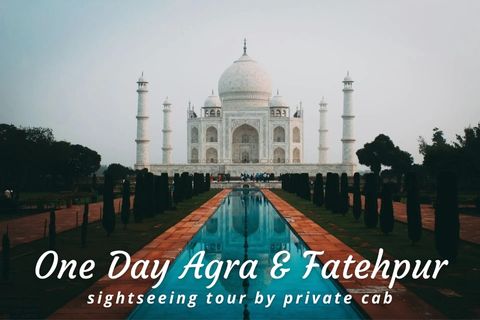Welcome to Fatehpur Sikri, a hidden gem on the outskirts of Agra. It’s a Heritage Site that stands as a testament to the grandeur of the Mughal Empire.
Fatehpur Sikri is an ancient town steeped in history and architectural splendour. It’s an entire complex of historical Mughal monuments, sitting majestically on a rocky ridge. And there are several marvels to discover in the top places to visit in Fatehpur Sikri.
The township was built by Emperor Akbar as his imperial capital. And much of this forgotten kingdom is still preserved, as if untouched by time.
You can explore many places in Fatehpur Sikri, like Jodha Bai’s Palace, Panch Mahal and the tomb of Salim Chishti. The town boasts an extraordinary blend of Islamic, Hindu and Persian architectural styles. Each destination has its own allure and significance.
The awe-inspiring magnificence of Fatehpur Sikri is visible from Buland Darwaza itself. It’s a 54-metre-high gateway that forms the main entrance of the palace.
Agra Fatehpur Sikri is a symphony of history, culture and architecture. And as you traverse the corridors, you’ll sure be intrigued by its majestic monuments and enchanting tales of the past. They attract many travellers from across the globe.
So, here’s a list of all the best places to visit in Fatehpur Sikri and nearby that you must explore.
1. Buland Darwaza

Buland Darwaza is a magnificent gateway in Fatehpur Sikri. The gateway is 54 metres high, and it’s known for its imperial grandeur and architectural beauty.
It was built to commemorate Emperor Akbar’s triumphant victory over Gujarat, and it stands as a symbol of power, authority, and conquest. Step through the gateway, and you enter a world steeped in history and culture.
The craftsmanship adorning Buland Darwaza leaves visitors spellbound with its sheer size and details. Its design consists of intricate carvings, delicate latticework on stone and complex geometrical patterns. Every motif and inscription is a part of the story of the Mughal empire.
Buland Darwaza also offers a breathtaking view of the surrounding landscape. Walk up the steps, and you’ll find the panoramic vista that stretches till the horizon.
- Timings: 6:00 AM – 6:00 PM
- Entry Fee: ₹50 (Indians, SAARC & BIMSTEC), ₹610 (Foreigners)
2. Jama Masjid
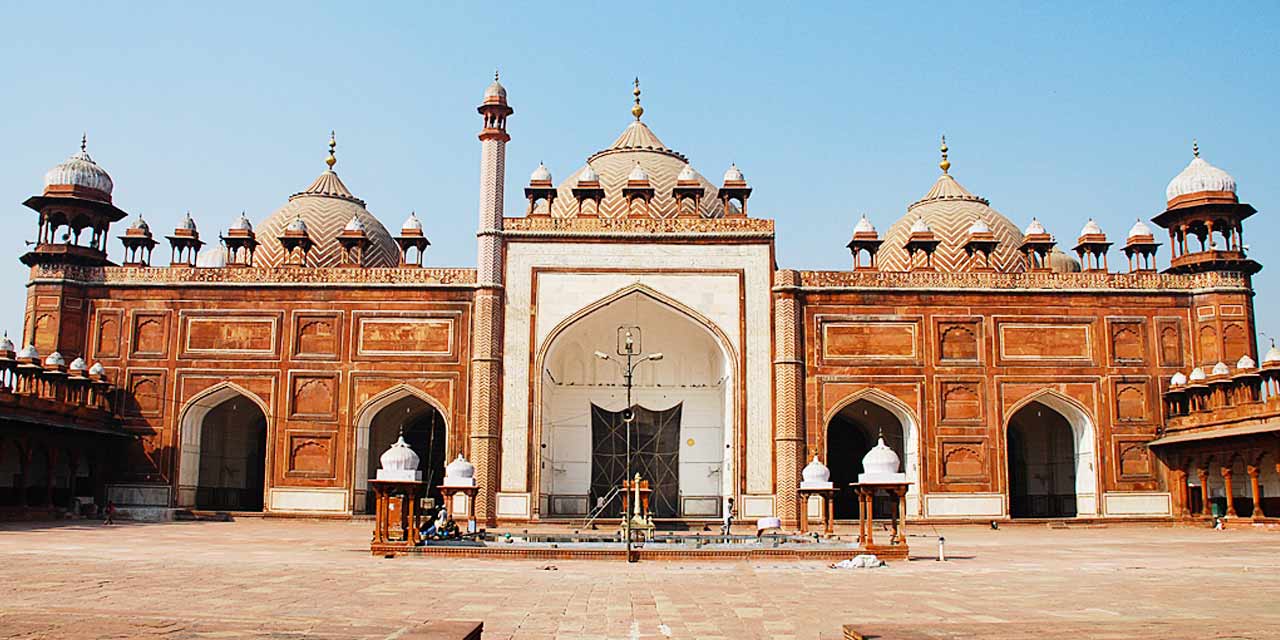
Jama Masjid is one of the largest mosques in India. It’s an architectural masterpiece nestled within the captivating town of Fatehpur Sikri.
Its vast courtyard is surrounded by imposing red sandstone walls. The moment you step into the complex, you get a glimpse of its architectural brilliance. The prayer hall has soaring domes and elegant pillars. And intricate motifs and Quran inscriptions decorate the walls.
But visiting Jama Masjid isn’t just an exploration of exquisite architecture. It’s also a journey of introspection and cultural understanding. It’s a sanctuary for reflection and prayer. A sense of tranquillity wraps around anyone visiting the mosque.
- Timings: 7:00 AM – 12:00 PM, 1:30 PM – 6:30 PM
- Entry Fee: Free
3. Panch Mahal
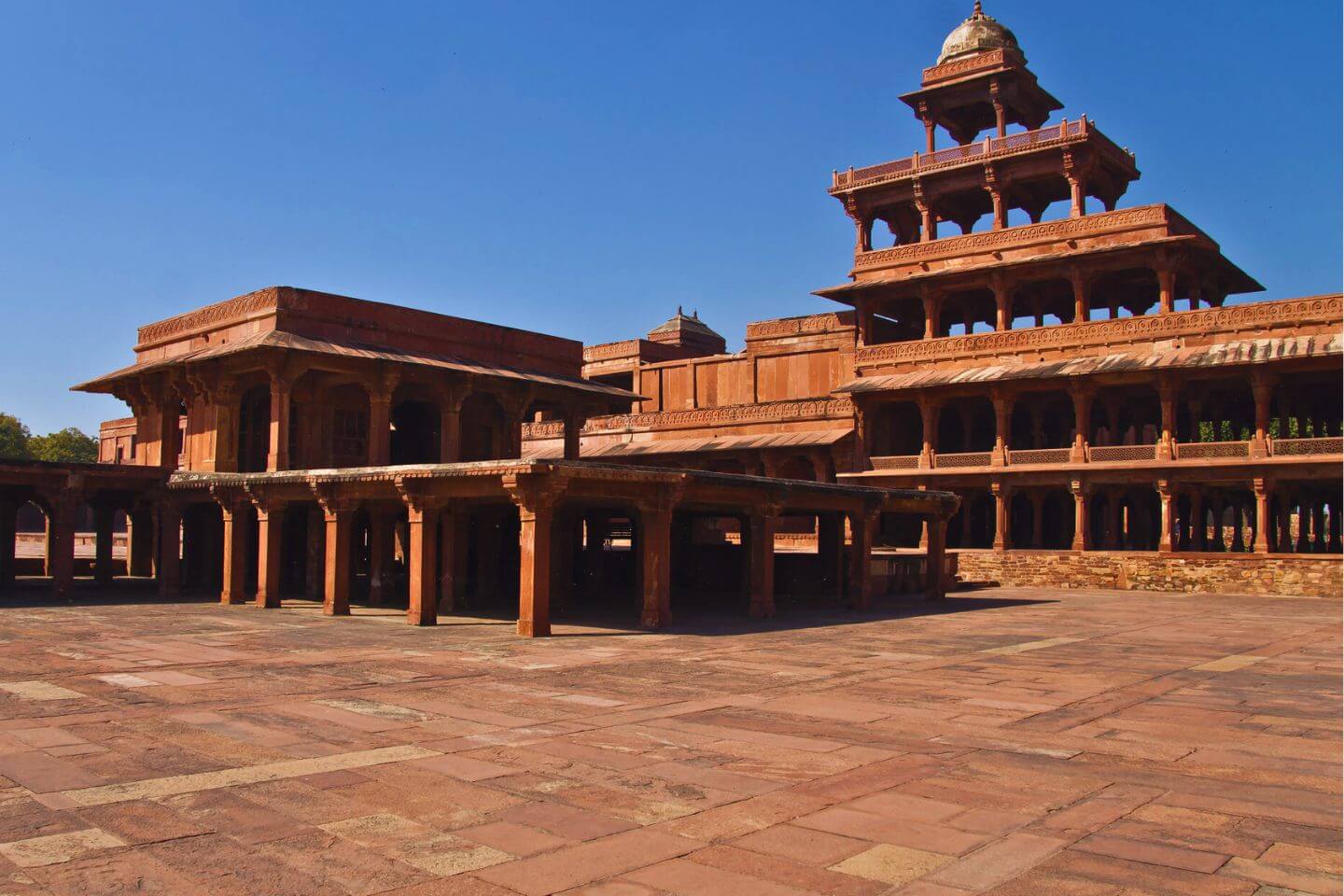
Panch Mahal is a mesmerizing five-storey palace near Jama Masjid. The palace stands as an elegant, unique and prominent attraction in Fatehpur Sikri. It’s another architectural wonder that displays the artistic brilliance and engineering prowess of the Mughal era artisans.
Each storey of Panch Mahal is progressively smaller than the lower one. And each is adorned with carved pillars, intricate brackets and ornate balustrades. It creates a graceful silhouette of the aesthetic structure that the palace is.
The palace holds a unique charm and offers a serene ambiance. Its architecture combines elements of Persian, Indian and Islamic styles.
Whether you are an architecture enthusiast or a history buff, you’ll love a visit to Panch Mahal.
- Timings: 6:00 AM – 6:00 PM
- Entry Fee: ₹50 (Indians, SAARC & BIMSTEC), ₹610 (Foreigners)
4. Jodha Bai Palace
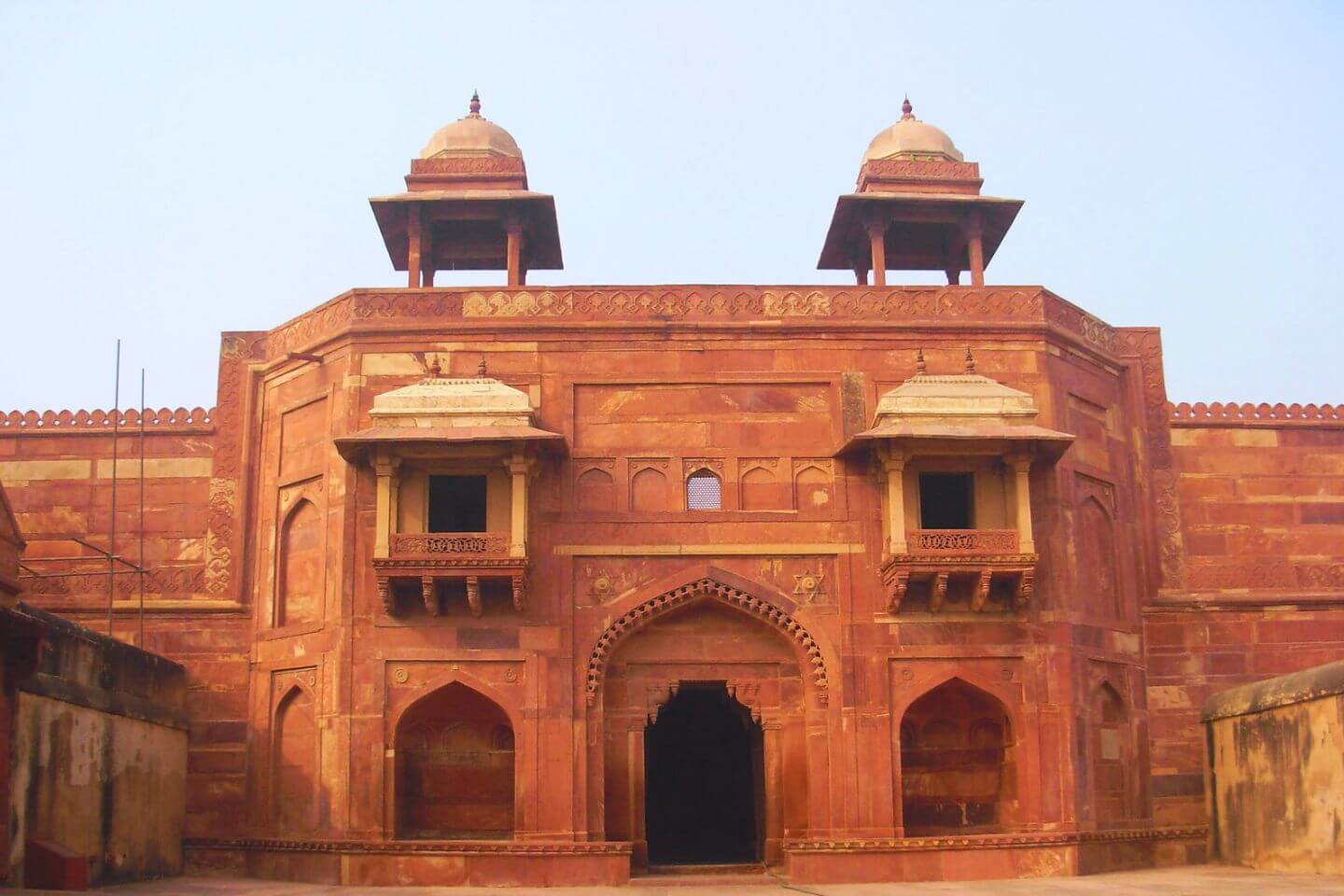
Jodha Bai Palace (also known as Mariam-uz-Zamani Palace) was the residence of Jodha Bai, Emperor Akbar’s favourite queen. With its blend of Rajput and Mughal architecture, the palace is a testimony to the cultural fusion during the Mughal era.
Jodha Bai was known for her grace, intelligence and strong influence on Emperor Akbar. And the building shows the respect and recognition she received.
Wandering through the palace, you can feel the grandeur of the daily life of the queen. It has sprawling courtyards and exquisite chambers. Delicate murals and geometric patterns grace the walls throughout.
It seamlessly integrates elements of Rajputana palaces with Mughal style. Intricately carved sandstone columns, elegant archways and ornate jaali (lattice) screens greet you as you enter.
- Timings: 6:00 AM – 6:00 PM
- Entry Fee: ₹50 (Indians, SAARC & BIMSTEC), ₹610 (Foreigners)
5. Tomb of Salim Chishti

The Tomb of Salim Chishti is another one of the famous places to visit in Fatehpur Sikri. It’s a place of deep reverence and spiritual significance. You’ll be struck by the sense of tranquillity that envelops the place.
This pristine white marble mausoleum is dedicated to the revered Sufi saint Salim Chishti. The structure stands as a symbol of devotion and faith.
It’s adorned with delicate latticework and intricate carvings. The lattice-style marble work filters the light that reaches the inside, creating a soothing ambiance. And the interior walls are decorated with floral patterns and calligraphy.
People from all walks of life come here to pay homage to Salim Chishti. Adjacent to the tomb, there’s the Jamaat Khana, where devotees gather to recite prayers. It’s believed that the tomb holds power to fulfill the wishes of anyone who visits with sincerity.
- Timings: 6:00 AM – 6:00 PM
- Entry Fee: ₹50 (Indians, SAARC & BIMSTEC), ₹610 (Foreigners)
6. Diwan-e-Khas

Diwan-e-Khas is a grand hall that Emperor Akbar used to entertain his special and eminent guests. It was the place to conduct discussions of utmost importance in private.
An intricately carved sandstone facade welcomes visitors as they approach Diwan-e-Khas. And much like other structures in Fatehpur Sikri, it’s a stellar example of the magnificence of the Mughal architectural style. It displays the craftsmanship that characterized the era.
Diwan-e-Khas offers a glimpse into the fascinating royal court. As you walk through the hall, you can almost imagine the grandeur of the past.
The spacious interior reflects a fusion of Hindu and Islamic artistic influences. It was where dignitaries, intellectuals and spiritual leaders held meetings with the emperor. It’s adorned with exquisite marble inlay work. You’ll feel an aura of power and authority here.
- Timings: 6:00 AM – 6:00 PM
- Entry Fee: ₹50 (Indians, SAARC & BIMSTEC), ₹610 (Foreigners)
7. Diwan-e-Aam
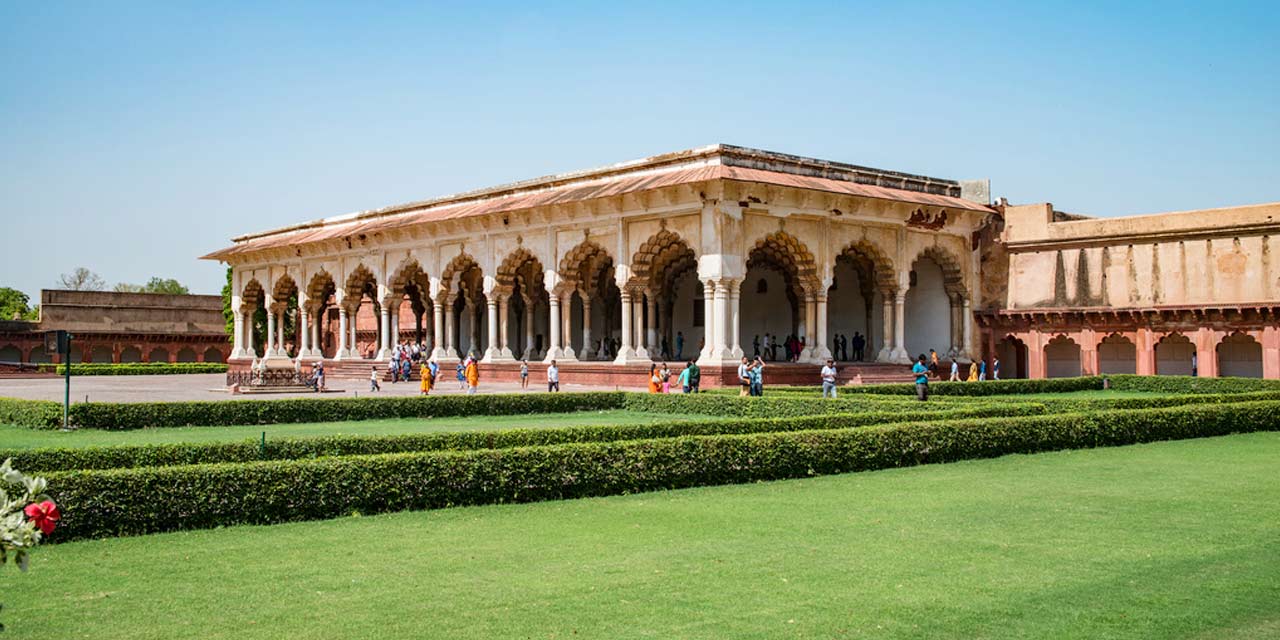
Diwan-e-Aam is another magnificent hall in the Fatehpur Sikri complex. It was meant for the public audience, for Emperor Akbar to meet with his subjects and listen to their grievances.
Similar to Diwan-e-Khas, Diwan-e-Aam greets you with an impressive sandstone facade. It’s adorned with intricate carvings and decorative elements. The ornate arches and delicate jaali screens on the exterior further enhance its beauty.
Its past grandeur is evident in its spacious layout and rich ornamentation. The focal point of the hall is the elevated platform, where the emperor sat on his throne. The acoustics were carefully designed to ensure Akbar could hear the voices of his subjects clearly.
- Timings: 6:00 AM – 6:00 PM
- Entry Fee: ₹50 (Indians, SAARC & BIMSTEC), ₹610 (Foreigners)
8. Birbal’s House
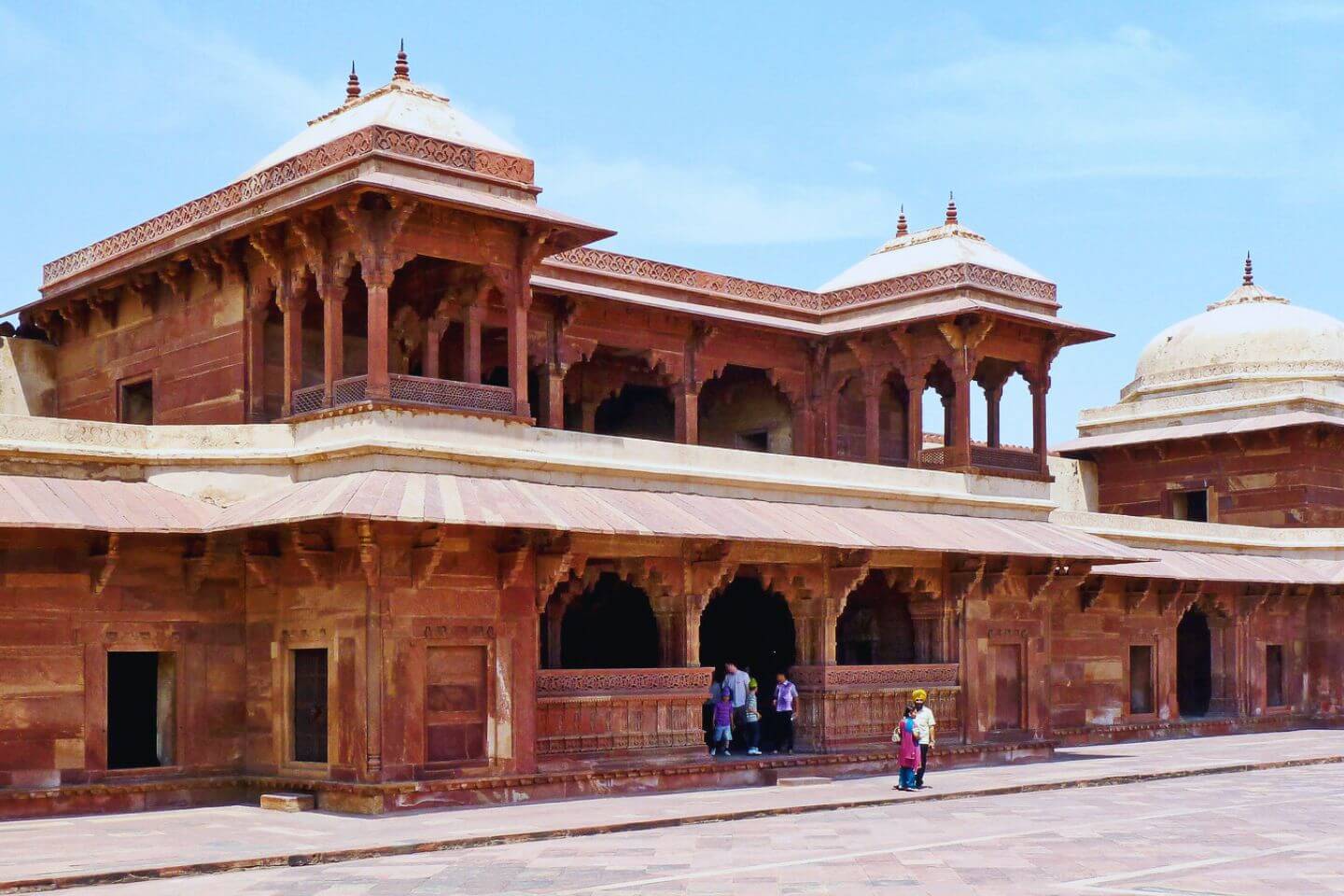
Birbal’s House is the place associated with Akbar’s advisor, Birbal. While the original structure has been lost to time, the site still provides a glimpse into the life of the court. It’s a place where intellectual debates, artistic pursuits and meaningful conversations thrived in the past.
Birbal’s House is a reminder of Birbal’s invaluable counsel to Emperor Akbar. Visiting it is like stepping into the pages of a lesser-known part of Mughal history.
It’s a witness to the bond between Emperor Akbar and his trusted advisor. Here, the stories of Akbar and Birbal come alive. You’ll remember his legendary wit and intelligence as you walk through the empty courtyards.
- Timings: 12:00 AM – 12:00 AM
- Entry Fee: ₹50 (Indians, SAARC & BIMSTEC), ₹610 (Foreigners)
9. Daulat Khana

Daulat Khana (also known as Khwabgah) is the most beautiful building in the royal complex. It was constructed for Emperor Akbar as his private palace for rest and contemplation, and it has a bedroom, a personal library and a small bathroom.
Daulat Khana is one of the most well-planned buildings in Fatehpur Sikri. It’s a double-storey building built with red sandstone.
And its design and architecture reflect the luxurious lifestyle of the Mughals. The bedroom is decorated with intricate patterns, vibrant colours and a few Persian inscriptions. Attention has been given to creating a space that’s both comfortable and opulent.
It’s believed that the library (or Kutub Khana) had over 25 thousand manuscripts along with other official documents. And it was connected to the offices (Daftar Khana) and palaces in the complex.
- Timings: 6:00 AM – 6:00 PM
- Entry Fee: ₹50 (Indians, SAARC & BIMSTEC), ₹610 (Foreigners)
10. Anup Talao
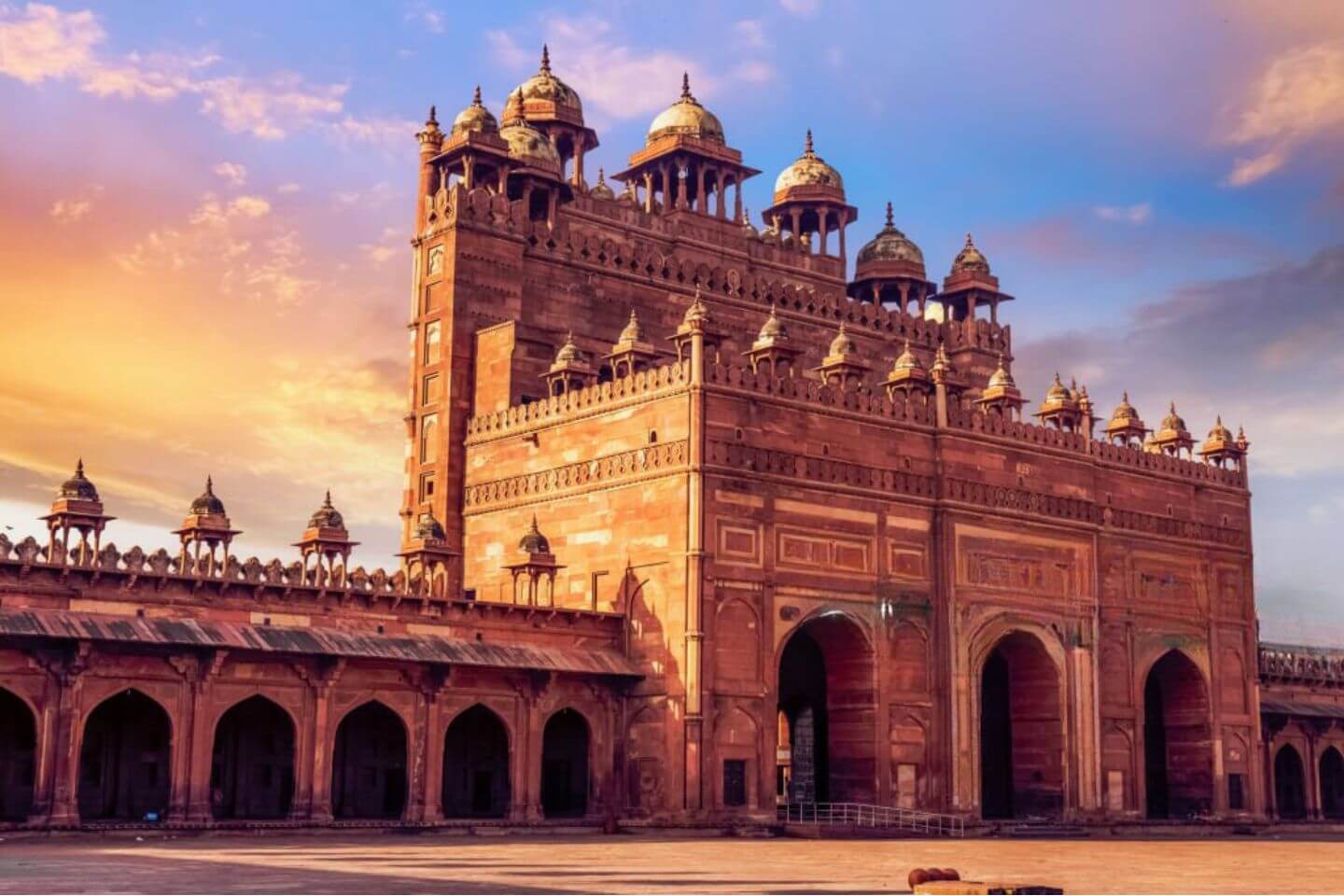
Anup Talao is a magnificent, ornamental pool in Fatehpur Sikri, near the Khwabgah building. It’s a one-of-its-kind water tank built in front of Akbar’s private quarters that adds to the charm and beauty of this massive historical complex.
It’s a red sandstone structure with an elevated platform in the centre. This platform has well-planned viewing and seating places around it. It acted as a private retreat for Akbar. He could admire the beauty of the place from this pool.
It’s believed that the tank was filled with copper, silver and gold coins that shimmered under the sun. These were later given away by Jehangir.
- Timings: 6:00 AM – 6:00 PM
- Entry Fee: ₹20 (Indians, SAARC & BIMSTEC), ₹250 (Foreigners)
11. Karawan Serai

Karawan Serai (or Caravan Serai) in Fatehpur Sikri is a large, walled inn built by the Mughal emperor Akbar. It served as a resting place and accommodation back in the day when the town was on the bustling caravan routes. Weary travellers and merchants came here to rest and socialise with other merchants.
The structure is built in a typical Mughal style. It has a large central courtyard surrounded by chambers where travellers could find respite. Besides the rooms, Karawan Serai also had terraces and pillared verandas, and a tank and a well.
It offers a panoramic rear view of the different palaces, along with a view of the countryside. And it provides a unique perspective on the complex, making it one of the must-visit places to see in Fatehpur Sikri.
- Timings: 6:00 AM – 6:00 PM
- Entry Fee: ₹50 (Indians, SAARC & BIMSTEC), ₹610 (Foreigners)
12. Hiran Minar

Hiran Minar in Fatehpur Sikri is a unique tower located close to Karawan Serai. It was built during the reign of Emperor Akbar. He built it as a memorial to a beloved pet elephant named Hiran, who was held in high regard.
This circular tower has a height of 21 m. And it’s built over an octagonal platform standing on a square base. It’s decorated with an alternate row of hexagons and six-point stars, along with elephant tusks.
From the top of Hiran Minar, you can get panoramic views of the surrounding area. It’s believed that it was used as a watch tower for the queens and the women of the royal family to watch ongoing games. It’s also believed that it served as a milepost for night travellers.
- Timings: 6:00 AM – 6:00 PM
- Entry Fee: ₹50 (Indians, SAARC & BIMSTEC), ₹610 (Foreigners)
13. Rang Mahal
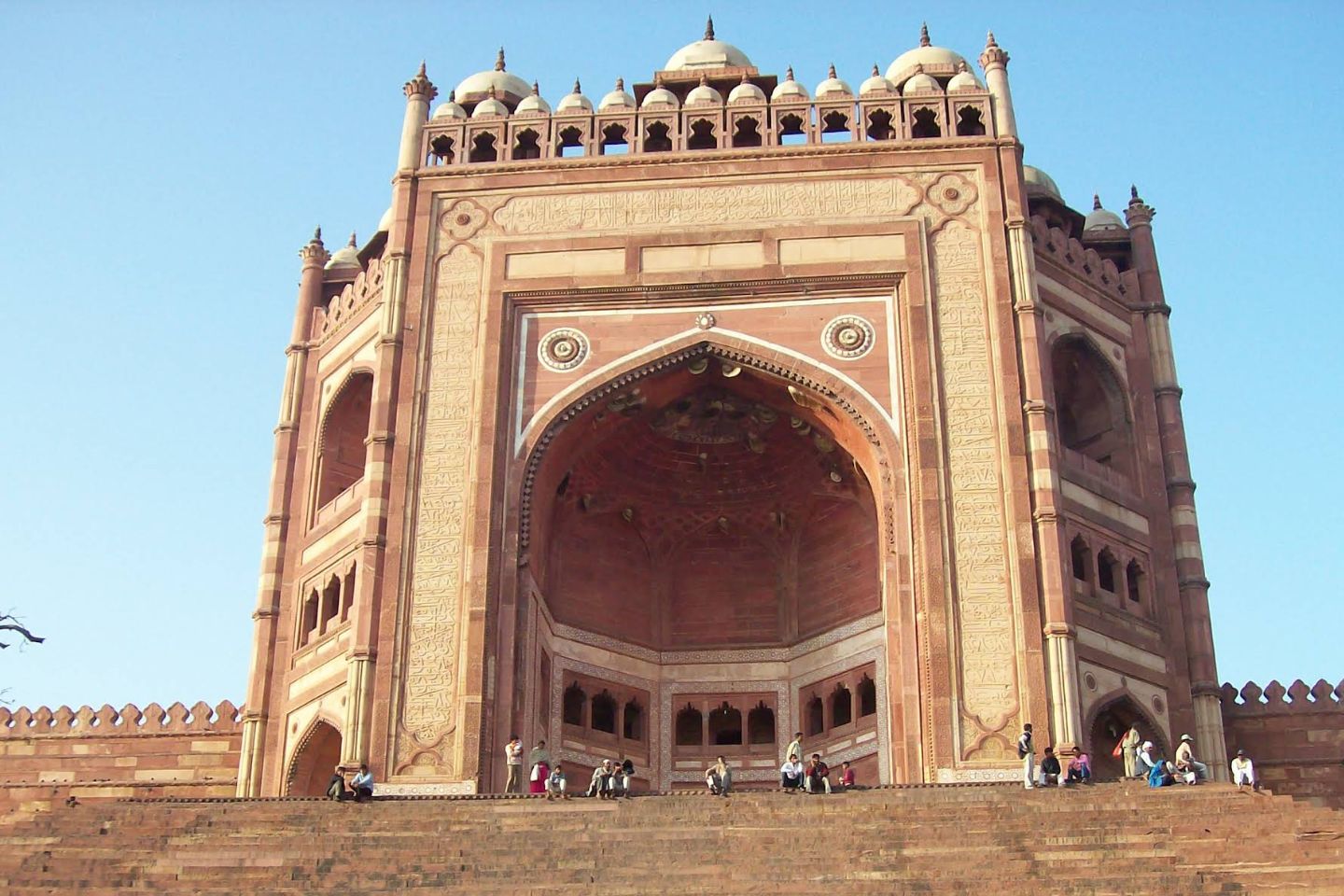
Rang Mahal (also called Pleasure Palace) is one of the oldest structures in Fatehpur Sikri. Its exquisite frescoes and decorative motifs were said to be used here for the first time. But they have now faded with time.
It’s said that Akbar built this red sandstone palace for his wife and that Prince Salim was born here. It has a double-storeyed living room, and its highlight is the brackets. Rang Mahal is said to have five inner courts, with one in the centre. But only a part of the palace has survived.
While the charm of Rang Mahal no longer exists, it has an air of elegance and splendour even in its ruins. It’s believed to be among the best examples of residential architecture in India in those days.
- Timings: 6:00 AM – 6:00 PM
- Entry Fee: ₹50 (Indians, SAARC & BIMSTEC), ₹610 (Foreigners)
14. Naubat Khana

Naubat Khana (also known as Naqqar Khana) is another significant structure in the Fatehpur Sikri complex. And it served as a place where ceremonial music was performed to announce the arrival of the emperor or other important dignitaries.
The structure is built in the traditional Mughal architectural style. And this Mughal elegance is most visible in the archways of this sandstone structure.
It’s close to Hathi Pol, where visitors had to disembark before proceeding any further. And apart from the customary announcement of the arrival of the emperor, music was also played here five times a day. It added a sense of regality and solemnity to the daily royal proceedings.
- Timings: 6:00 AM – 6:00 PM
- Entry Fee: ₹50 (Indians, SAARC & BIMSTEC), ₹610 (Foreigners)
15. Samosa Mahal

Samosa Mahal is a single-storeyed building with an irregular courtyard. While it doesn’t have any mention in historical texts, it’s still among the popular places to visit in Fatehpur Sikri, primarily because of its shape.
The palace is built with red and grey sandstone. And its shape resembles a triangle, like the shape of an Indian fried snack called samosa.
It’s assumed to be the residence of one of the nobles of Akbar. And it has been thoughtfully designed, keeping in mind the comforts of the occupants. It has several rooms, and hammams (baths) and toilets. Ornamental arches adorn the walls, and you can see traces of paintings on the interior walls.
- Timings: 6:00 AM – 6:00 PM
- Entry Fee: ₹50 (Indians, SAARC & BIMSTEC), ₹610 (Foreigners)
Other Places to Visit in Fatehpur Sikri
The places in the list help you understand the importance of Fatehpur Sikri in detail. Apart from those, there are many other places to see near Agra Fatehpur Sikri.
You can begin with Sunahra Makan (meaning “Golden House''). It’s an architectural gem that’s believed to have been a residence for high-ranking officials. Hathi Pol (or Elephant Gate) is another remarkable example of Mughal architecture in the Fatehpur Sikri complex.
The tomb of Sheikh Ibrahim Chishti is also nearby.
And if you want to explore Mughal history further, you must also visit the Taj Mahal in Agra and the Agra Fort complex. Nearby, you can visit the tomb of Emperor Akbar and Mariam-uz-Zamani Tomb. They’re among the top places to visit in Agra and Fatehpur Sikri.
Among the few other places to visit near Fatehpur Sikri is Keoladeo National Park (also known as Bharatpur Bird Sanctuary). It’s home to a wide variety of migratory and resident birds. A popular Hindu temple, called Keoladeo Shiva Temple, is also here.
From the ethereal beauty of the Tomb of Salim Chishti to the regal grandeur of Diwan-e-Khas and Diwan-e-Aam, Fatehpur Sikri is a rich amalgam of history, art and spirituality. It’s a blend of historical treasures and architectural wonders.
The complex offers a new perspective on the life of the Mughal rulers. All the places to visit in Fatehpur Sikri have their own mystic charm that waits to embrace you. Even beyond its well-known attractions, the fort complex brims with hidden gems and intriguing stories waiting to be explored.
Prepare to be captivated, inspired and enchanted with what Fatehpur Sikri has to offer. Plan your visit, ideally between November and February, when the weather is at its most inviting.



